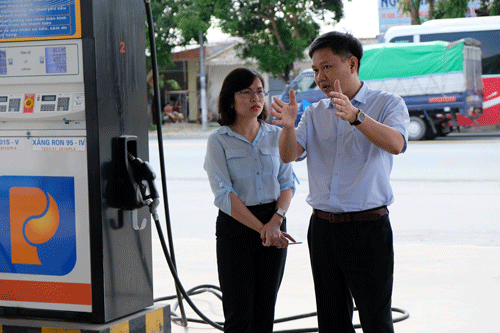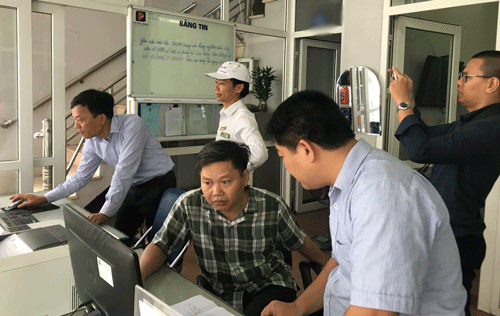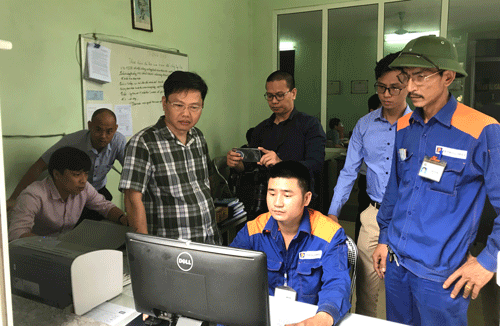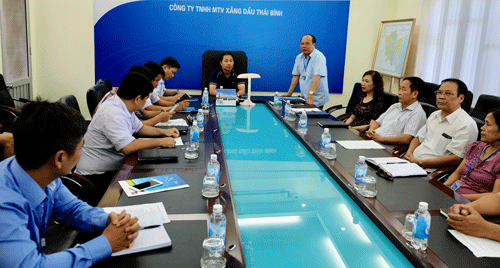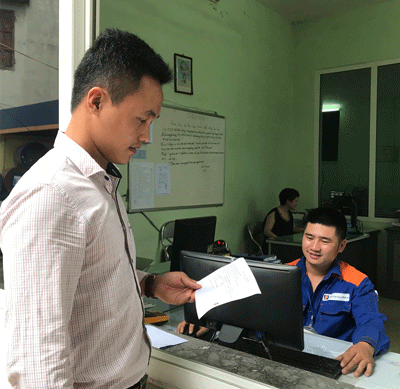PLX prints receipt at stations from July 1
As of July 1, 2018 Petrolimex/PLX officially prints sale receipt at all Petrolimex petrol stations as regulated in the Ministry of Science and Technology’s Circular No 15/2015/TT-BKHCN. The Cong Thuong (Industry & Trade) magazine speaks to Deputy Director General of the Vietnam National Petroleum Group Nguyen Quang Dung to learn more about the practice.
The magazine: Could you please elaborate PLX’s official use of print receipt [at petrol stations] from July 1, 2018?
Nguyen Quang Dung: PLX’s on-the-spot receipt printing accords with the Ministry of Science and Technology’s Circular No 15/2015/TT-BKHCN dated August 25, 2015 and entitled “Metrology quality standards in petroleum trading operations”.
Final check on receipt printer at Petrolimex Hai Phong in Hai Phong City
The magazine:Receipts will be printed to deliver to all customers or only on request?
Nguyen Quang Dung: Document No 1287/TĐC-HCHQ dated May 17, 2018 by Directorate for Standards - Metrology - Quality which guides the implementation of Circular 15 does not require receipt printing after each pump.
Therefore, if any customer want to take a receipt when purchasing petrol at PLX service stations, receipt will be issued and given to the customer.
By the way I would like to reiterate that besides that type of receipt; from April 1 PLX started using e-invoice to replace normal paper invoice. Up to now, after three months of implementation, PLX’s e-invoice has been well received by customers, particularly customers like State bodies and enterprises that need invoices for accounting purposes as regulated by the State.
The magazine: Which pertinent details are included in receipts issued at petrol stations and what is basis of such details?
Nguyen Quang Dung: In accordance with Circular 15 and Guideline 1287, information required in each receipt consists of: the name of the seller (in this case, petrol station); the number sign of the fuel dispenser; the date the invoice was issued; the type of petrol, the quantity, the price and the total payment to be made.
As such, there are seven parameters in total.
The magazine:Are data printed out online or offline? Will the receipt be printed out automatically upon the completion of each pump or by a petrol station worker upon customer’s request?
Nguyen Quang Dung: Data printed out are online. Petrol station’s office will issue receipt upon customer’s request.
The printer can print receipt automatically or on demand; but information printed out is online, not offline.
The magazine: Will the receipt printing give rise to costs for PLX? What is the cost [of the project] and of each receipt?
Nguyen Quang Dung: Costs arising include investment for printing equipment, printing paper, and synchronous implementation of [receipt printing] at petrol stations nationwide. Petrolimex’s petrol stations management tools available such as Egas, ERP are favourable bases for us to carry out Circular 15.
The magazine: PLX already used e-invoice from April 1, 2018, and now directly issues sale receipt. What is the relation and difference between e-invoice and sale receipt?
Nguyen Quang Dung: The difference is that: one receipt contains the information of each pump, only seven pieces of information as stipulated in the Circular 15 as mentioned above.
Information contained in both sale receipt and e-invoice are adequate according to State regulations.
The magazine: Is there any other petroleum retailer in Vietnam that also issues print receipt at petrol station?
Nguyen Quang Dung: In accordance with Circular 15 and Guideline 1287, all petroleum businesses, not only PLX, must do so.
We believe that other businesses are quickly implementing these regulations in line with solutions most suitable with their own operations.
At Petrolimex Hanoi’s petrol station No 65
The magazine: The receipt printing will also add extra work at petrol station. Does this affect the sale of petrol, especially during peak hours when PLX petrol stations are full of customers who all want to have their vehicles be quickly filled to continue their travel?
Nguyen Quang Dung: During peak hours, PLX petrol stations in Hanoi, HCM City, and other urban centres across the country are full of customers – that is a reality.
Purchasing petrol at peak hours, every customer is in a hurry, and that is the common psychology of all customers; but the receipt printing upon customer’s demand accords with State regulations for petroleum transparency and protection of legitimate interests of customers.
Therefore, we are convinced that customers will support PLX. On the PLX side, our sales staff will make the best efforts to make sure that customers can buy petrol and take receipt (upon request) in the shortest time possible.
The magazine: Did you promote this at PLX petrol stations or by which way?
Nguyen Quang Dung: With the customer-centric mindset, PLX launched a programme to promote communications at PLX petrol stations from April 2017 (according to Document 0459/PLX-TGĐ); accordingly, PLX petrol stations are installed with means of communications to inform customers of new products, new services and promotion programmes (if any), Q&A related to situations arising at petrol stations, and so forth on the basis of the “PLX Music and Sound” system.
We also use this system to inform customers of our implementation of Circular 15 besides other communications tools such as website www.petrolimex.com.vn and fanpage of the Vietnam National Petroleum Group – Petrolimex.
Information published by Petrolimex on the website www.petrolimex.com.vn is official/formal information that media practitioners can use.
The magazine: What will you do if customers don’t want to take receipt straightway but return to the petrol station to receive it later?
Nguyen Quang Dung: Technically speaking, PLX still can issue the receipt provided that the customer remember exactly information related to: the time of purchase, petrol type, the quantity & total payment, and the fuel dispenser.
Being informed of all these information, the petrol station’s office will track the data saved on computer system and print out the receipt for customer.
The magazine: Did you modify the 5-Step Process to ask a customer whether s/he would like take a sale receipt and add actual situations to address matters arising from receipt printing?
Nguyen Quang Dung: The 5-Step Process is an educational film that PLX made with the aim to unify the communication process when selling petrol at filling stations, ensuring commercial civilisation and petroleum transparency to customers and corresponding to Vietnamese culture.
Besides the 5-Step Process, PLX also produced a 15-episode film highlighting 15 situations commonly seen at petrol stations to solve customers’ concerns as well as to instruct petrol stations’ workers to handle situations that may arise in reality.
The 5-Step Process and 15 situations are fundamental matters; but not all situations that often occur in real life. PLX will continue studying to have instructions suitable with our customer centricity. The making of any educational film will require time for research and developing script, which cannot be done overnight.
The magazine: Will print receipts be applied in all PLX petrol stations from July 1 or only those qualified? What is the roadmap?
Nguyen Quang Dung: PLX instructed all member companies to use print receipts from July 1, 2018.
The magazine: Will PLX use self-printed receipt at petrol stations abroad or in Vietnam only?
Nguyen Quang Dung: Receipts implemented in line with Circular 15 and this circular shall only be effective within Vietnamese territory. The trading of petroleum abroad abides by the law and related regulations of the host country.
Thank you for your time!
Photos depict final check on the preparation for receipt printing throughout the whole system of PLX petrol stations:
At Petrolimex Nam Dinh
At petrol station No 23 Xa La (Petrolimex Ha Son Binh)
At Petrolimex Thai Binh
Customer receives print receipt from a Petrolimex’s petrol station
